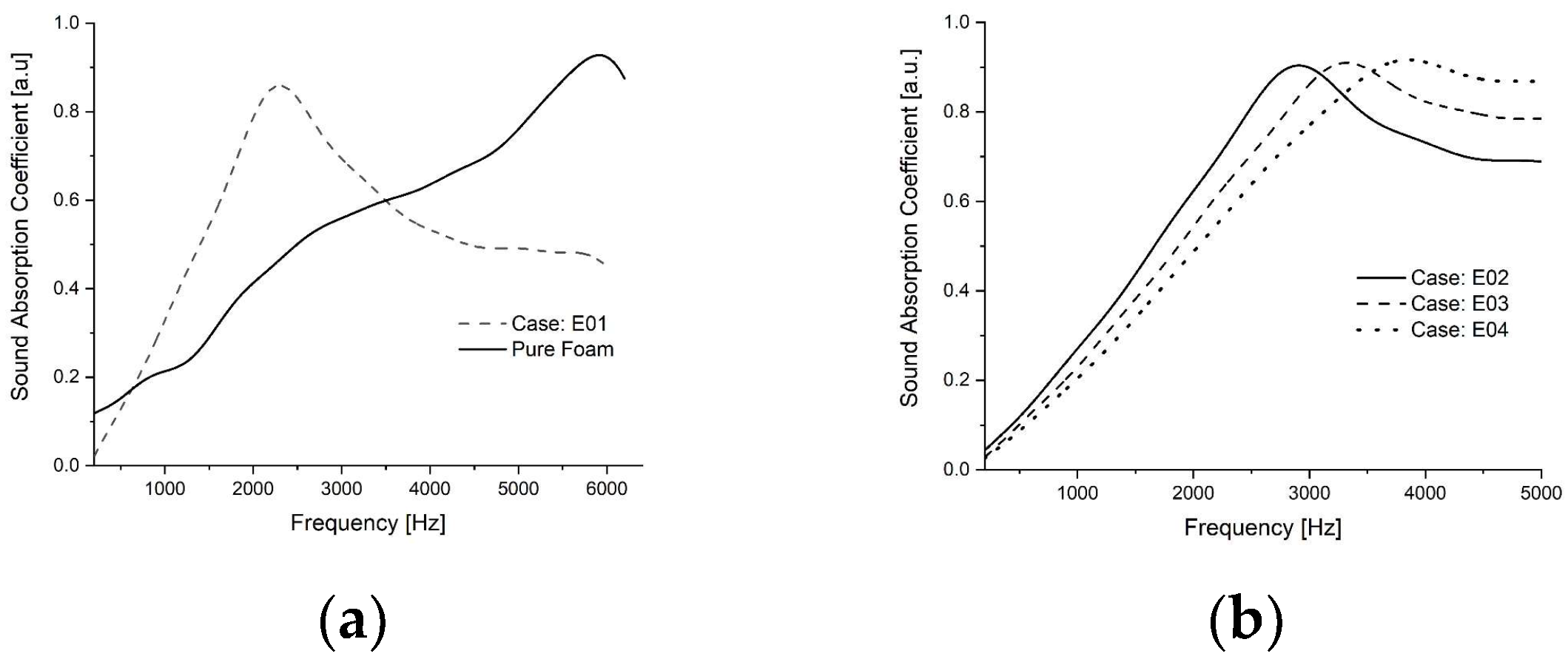Nanomembranes and Urban Vehicles: A Simple Way to Minimize Urban Noise †
Abstract
1. Introduction
2. Materials and Methods
3. Results and Discussion
4. Conclusions
Author Contributions
Funding
Institutional Review Board Statement
Informed Consent Statement
Data Availability Statement
Conflicts of Interest
References
- De Paiva Vianna, K.M.; Alves Cardoso, M.R.; Rodrigues, R.M.C. Noise Pollution and Annoyance: An Urban Soundscapes Study. Noise Health 2015, 17, 125–133. [Google Scholar] [CrossRef]
- Hao, G.; Zuo, L.; Weng, X.; Fei, Q.; Zhang, Z.; Chen, L.; Wang, Z.; Jing, C. Associations of Road Traffic Noise with Cardiovascular Diseases and Mortality: Longitudinal Results from UK Biobank and Meta-Analysis. Environ. Res. 2022, 212, 113129. [Google Scholar] [CrossRef] [PubMed]
- Sørensen, M.; Hvidtfeldt, U.A.; Poulsen, A.H.; Thygesen, L.C.; Frohn, L.M.; Khan, J.; Raaschou-Nielsen, O. Long-Term Exposure to Transportation Noise and Risk of Type 2 Diabetes: A Cohort Study. Environ. Res. 2023, 217, 114795. [Google Scholar] [CrossRef]
- McBride, S.; Burdisso, R.; Sandu, C. Modeling Vibration-Induced Tire-Pavement Interaction Noise in the Mid-Frequency Range. Tire Sci. Technol. 2021, 49, 146–169. [Google Scholar] [CrossRef]
- Van Renterghem, T.; Vanhecke, K.; Filipan, K.; Sun, K.; De Pessemier, T.; De Coensel, B.; Joseph, W.; Botteldooren, D. Interactive Soundscape Augmentation by Natural Sounds in a Noise Polluted Urban Park. Landsc. Urban Plan. 2020, 194, 103705. [Google Scholar] [CrossRef]
- Shin, S.; Bai, L.; Oiamo, T.H.; Burnett, R.T.; Weichenthal, S.; Jerrett, M.; Kwong, J.C.; Goldberg, M.S.; Copes, R.; Kopp, A.; et al. Association between Road Traffic Noise and Incidence of Diabetes Mellitus and Hypertension in Toronto, Canada: A Population-Based Cohort Study. J. Am. Heart Assoc. 2020, 9, e013021. [Google Scholar] [CrossRef] [PubMed]
- Soni, A.R.; Makde, K.; Amrit, K.; Vijay, R.; Kumar, R. Noise Prediction and Environmental Noise Capacity for Urban Traffic of Mumbai. Appl. Acoust. 2022, 188, 108516. [Google Scholar] [CrossRef]
- Faulkner, J.P.; Murphy, E. Road Traffic Noise Modelling and Population Exposure Estimation Using CNOSSOS-EU: Insights from Ireland. Appl. Acoust. 2022, 192, 108692. [Google Scholar] [CrossRef]
- do Nascimento, E.O.; de Oliveira, F.L.; de Oliveira, L.N.; Zannin, P.H.T. Noise Prediction Based on Acoustic Maps and Vehicle Fleet Composition. Appl. Acoust. 2021, 174, 107803. [Google Scholar] [CrossRef]
- ASTM C384-04; Standard Test Method for Impedance and Absorption of Acoustical Materials by Impedance Tube Method. ASTM International: West Conshohocken, PA, USA, 2022.
- Leão, S.G.; Monteiro, E.C.; dos Reis, M.O.; Mapa, L.P.P.; Avila, A.F. Noise Attenuation inside Airplane Cabin: Preliminary Results on Combined Porous/Nano-Fibrous Materials. Appl. Acoust. 2022, 199, 109009. [Google Scholar] [CrossRef]
- Mahesh, K.; Mini, R.S. Helmholtz Resonator Based Metamaterials for Sound Manipulation. J. Phys. Conf. Ser. 2019, 1355, 012031. [Google Scholar] [CrossRef]
- Roca-Barceló, A.; Nardocci, A.; de Aguiar, B.S.; Ribeiro, A.G.; Failla, M.A.; Hansell, A.L.; Cardoso, M.R.; Piel, F.B. Risk of Cardiovascular Mortality, Stroke and Coronary Heart Mortality Associated with Aircraft Noise around Congonhas Airport, São Paulo, Brazil: A Small-Area Study. Environ. Health 2021, 20, 59. [Google Scholar] [CrossRef] [PubMed]


| Group ID | PVdF-HFP [% w/w] | CNT [% w] | SDBS [ppm] | SDBS [%w] |
|---|---|---|---|---|
| E1 | 12 | 0.00 | -- | -- |
| E2 | 12 | 0.20 | -- | -- |
| E3 | 12 | 0.20 | 100 | -- |
| E4 | 12 | 0.20 | -- | 0.20 |
| Group ID | Fiber Diameter [nm] | Porous Diameter [µm] | Thickness [µm] |
|---|---|---|---|
| E1 | 216.68 ± 55.71 | 1.36 ± 0.27 | 7.80 |
| E2 | 130.01 ± 23.23 | 1.24 ± 0.32 | 4.68 |
| E3 | 188.67 ± 20.04 | 1.72 ± 0.47 | 6.79 |
| E4 | 146.68 ± 26.66 | 1.76 ± 0.45 | 5.28 |
| Group ID | Peak Absorption Coefficient [a.u.] | Peak Frequency [Hz] | Peak Noise Drop [dB] | Mean Noise Drop [dB] |
|---|---|---|---|---|
| E1 | 0.85 | 2388 | 19.81 | 11.16 |
| E2 | 0.89 | 3006 | 20.34 | 11.45 |
| E3 | 0.90 | 3435 | 20.44 | 11.21 |
| E4 | 0.91 | 3996 | 21.58 | 10.27 |
Disclaimer/Publisher’s Note: The statements, opinions and data contained in all publications are solely those of the individual author(s) and contributor(s) and not of MDPI and/or the editor(s). MDPI and/or the editor(s) disclaim responsibility for any injury to people or property resulting from any ideas, methods, instructions or products referred to in the content. |
© 2025 by the authors. Licensee MDPI, Basel, Switzerland. This article is an open access article distributed under the terms and conditions of the Creative Commons Attribution (CC BY) license (https://creativecommons.org/licenses/by/4.0/).
Share and Cite
Monteiro, E.C.; Avila, A.F. Nanomembranes and Urban Vehicles: A Simple Way to Minimize Urban Noise. Mater. Proc. 2025, 21, 3. https://doi.org/10.3390/materproc2025021003
Monteiro EC, Avila AF. Nanomembranes and Urban Vehicles: A Simple Way to Minimize Urban Noise. Materials Proceedings. 2025; 21(1):3. https://doi.org/10.3390/materproc2025021003
Chicago/Turabian StyleMonteiro, Elvis C., and Antonio F. Avila. 2025. "Nanomembranes and Urban Vehicles: A Simple Way to Minimize Urban Noise" Materials Proceedings 21, no. 1: 3. https://doi.org/10.3390/materproc2025021003
APA StyleMonteiro, E. C., & Avila, A. F. (2025). Nanomembranes and Urban Vehicles: A Simple Way to Minimize Urban Noise. Materials Proceedings, 21(1), 3. https://doi.org/10.3390/materproc2025021003






